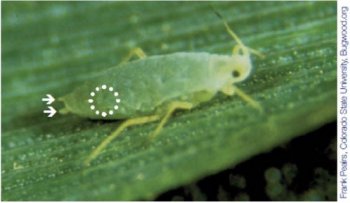
The Russian Wheat Aphid feeds mainly on wheat and barley, but can affect most cereal crops. The pest has recently been found in South Australia, and there is a risk that it could blow across the Tasman.
Farmers are advised to keep an eye out, and remain vigilant.
Incursion signs include:
- White, purple, or yellowish streaks on leaves;
- Trapped awns as a result of rolled flag leaf;
- Bleached grain heads.
These symptoms are also common with other diseases and disorders, however, if any are seen in combination, it is recommended to have them checked by an expert.
The pest was first reported in South Australia just north of Adelaide on 19 May.
Devastating fires ran across this cropping country last summer. Cereal volunteers encouraged by the late summer rains may have formed a more attractive green bridge to aphids than cereal volunteers present in retained stubble.
Biosecurity SA initially attempted to eradicate the aphid with insecticides, based on information from the US,. However RWA has been found on more than 93 cropping properties in South Australia covering over 20,500 square kilometres. The response to the pest rapidly moved from an eradication phase into a management phase.
Despite the name, the greatest yield loss and most severe damage is in barley and durum wheat but the aphid has a wide spectrum of cereal crop and weed grass hosts.
Where did it come from?
This is still a point of conjecture with either arriving on ornamental or pot plants, or blown over in the upper atmosphere from South Africa, as two options.
What is different about the symptoms caused by this aphid?
Whilst this aphid species does have distinctive features, such as absence of siphuncles or abdominal tubes, ‘exhaust pipes’, on the rear of the abdomen, most diagnosis of the problem has come about from looking for the symptoms in the cereal crops.
The aphid is not a vector for a virus but relays a toxin into the plant when it feeds. The toxin causes the cereal plant leaves and tillers to roll. Affected tillers also show distinct whitening of the tissues.
In early sown (March) barley, the effect has been so severe that barley crops look like fine leaved ryegrass crops. Luckily, these symptoms do not appear to affect the whole plant in the way that Barley Yellow Dwarf Virus (BYDV) does, such that following spraying the new emerging tillers appear to grow normally with no sign of the distortion.
Control
As more is learned from the field and from overseas data researchers have moved to suggestions of thresholds for control, for example, 20% plants with symptoms before spraying is warranted at the tillering stage.
As the crops move into stem elongation thresholds drop to 10% since the concern is feeding on the top three leaves of the plant.
Watching brief
FAR Australia and FAR in New Zealand are monitoring the response to this aphid so that should this pest migrate across the Tasman to New Zealand, the country could respond appropriately.
In a conventional system, an insecticide could now be considered on cereal crops that have reached GS 21. If integrated pest management is used, the decision is based on monitoring.
If aphids are found in the crop after the seed treatment is no longer active, and there are insufficient beneficial predators detected, then a selective aphicide, such as pirimicarb, could be considered. For it to work effectively it must be applied in the morning of a sunny day (higher rates are required if weather is cloudy).



 Classifieds
Classifieds

